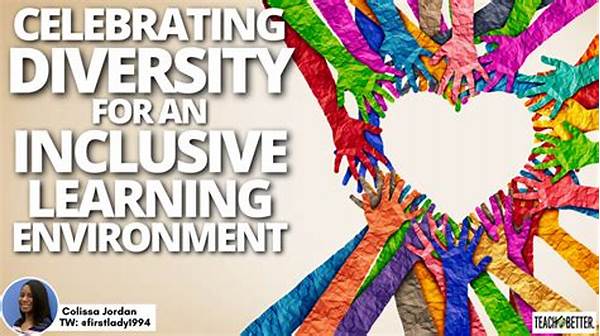Importance of Building a Multicultural Learning Environment
In today’s globalized world, education systems must embrace multiculturalism to prepare students for diverse societies. Building a multicultural learning environment fosters inclusive educational spaces where differences are celebrated, and students from all backgrounds feel valued. This approach enhances cultural awareness, reduces prejudice, and promotes mutual respect.
Read Now : Interactive Drama Classes Children
A multicultural learning environment enables students to gain comprehensive perspectives. Engaging with diverse cultures broadens intellect and helps students develop empathy towards varied worldviews. Educators play a pivotal role in cultivating such environments through inclusive curricula that reflect global diversity. By showcasing contributions from various cultures, teachers can provide a holistic educational experience fostering unity in diversity.
Challenges in building a multicultural learning environment exist, but the benefits far outweigh them. Educators face difficulties in language barriers, resource limitations, and curriculum constraints. However, schools that prioritize multicultural education contribute to creating harmonious societies. They nurture well-rounded individuals who appreciate cultural nuances and promote social cohesion. Commitment to overcoming challenges ensures the success of multicultural initiatives, reaping long-term societal benefits.
Strategies for Building a Multicultural Learning Environment
1. Inclusive Curriculum Design: Incorporating diverse cultural perspectives within curricula is essential for building a multicultural learning environment. It ensures students are exposed to a variety of worldviews, promoting appreciation and understanding of global diversity.
2. Culturally Responsive Teaching: Implementing teaching methods that recognize and respect student diversity enhances the multicultural learning environment. Educators can adapt their approaches to suit the cultural needs of their students, fostering inclusivity and engagement.
3. Language Support Programs: Building a multicultural learning environment often requires addressing language barriers. Providing language support and ESL programs can help non-native speakers integrate and actively participate in classroom activities.
4. Diverse Classroom Materials: Utilizing culturally diverse texts and resources ensures representation of different cultures. Building a multicultural learning environment is enriched by materials that reflect the students’ backgrounds and broaden their global understanding.
5. Cultural Exchange Initiatives: Encouraging cultural exchange activities and partnerships with global institutions can foster mutual understanding and learning. Such initiatives are essential in building a multicultural learning environment that values diversity as a strength.
Benefits of Building a Multicultural Learning Environment
Promoting equality and inclusivity is one of the primary advantages of building a multicultural learning environment. Such spaces ensure that every student, irrespective of their cultural background, receives equal educational opportunities. This egalitarian approach reduces educational disparities and fosters an inclusive atmosphere conducive to learning.
Another significant benefit lies in enhancing students’ cognitive and social abilities. Exposure to multiple cultures within a learning environment cultivates open-mindedness and critical thinking. Students learn to appreciate diverse viewpoints, aiding in the development of strong interpersonal skills. These skills are invaluable in preparing them for future global interactions and collaborations.
Building a multicultural learning environment also encourages collaboration and unity within the educational community. When students, educators, and stakeholders embrace multicultural principles, they contribute to creating a learning atmosphere characterized by respect and cooperation. This collective effort not only enhances individual learning experiences but also strengthens communal bonds.
Challenges in Building a Multicultural Learning Environment
Building a multicultural learning environment can present several challenges. Among these is the potential resistance from educators unfamiliar with multicultural pedagogies. Resistance often stems from lack of training or understanding of the benefits of multicultural education. Overcoming such resistance is essential to effectively implement inclusive teaching practices that support diverse learners.
Read Now : Starting A Digital Venture
Another challenge is addressing existing biases within the educational framework. Curricular and institutional biases may inadvertently marginalize certain cultural groups. Building a multicultural learning environment requires intentional efforts to identify and eliminate such biases, ensuring fair representation and consideration of all cultural perspectives.
Resource constraints also pose challenges to building a multicultural learning environment. Adequate funding is necessary to provide essential resources, such as diverse learning materials and professional development for educators. Overcoming resource limitations requires a collaborative effort among educational stakeholders to prioritize and allocate resources effectively.
Implementing Policies for Building a Multicultural Learning Environment
The successful implementation of policies is crucial for building a multicultural learning environment. Educational institutions must prioritize policy frameworks that support diversity and inclusivity. This includes developing guidelines and standards that foster equitable access to educational opportunities for all students.
Building a multicultural learning environment through effective policy implementation also involves continuous evaluation and adaptation of existing practices. Regular assessment of multicultural initiatives ensures they remain relevant and effective. Institutions should engage in ongoing dialogue with diverse communities to refine policies and promote inclusive educational experiences.
Framework for Building a Multicultural Learning Environment
A strategic framework is vital for building a multicultural learning environment. Such frameworks encompass several dimensions, including curriculum design, pedagogical approaches, and institutional policies. Ensuring alignment across these dimensions encourages coherent practices that foster diversity and inclusion.
Professional development is a cornerstone of the framework for building a multicultural learning environment. Providing educators with the necessary skills and knowledge equips them to effectively implement multicultural pedagogies. Training programs enrich educators’ understanding of cultural diversity and enhance their ability to facilitate inclusive learning experiences.
Conclusion: Building a Multicultural Learning Environment
In conclusion, building a multicultural learning environment is essential in today’s increasingly diverse educational landscape. Such environments not only provide students with rich learning experiences but also prepare them for participation in a global society. The integration of diverse cultural perspectives within educational systems promotes inclusivity, understanding, and respect for all cultures.
Challenges associated with building a multicultural learning environment necessitate committed efforts from educators, institutions, and policymakers. By overcoming obstacles such as resource limitations and institutional biases, educational communities can cultivate inclusive and harmonious learning spaces.
Ultimately, building a multicultural learning environment equips students with the cultural competencies required to thrive in an interconnected world. It fosters academic and personal growth, equipping learners with the skills necessary to engage in meaningful interactions across cultural boundaries. The continuous pursuit of multicultural education principles will remain instrumental in shaping future generations of culturally aware and socially responsible individuals.
